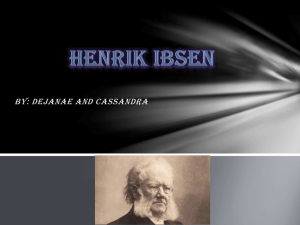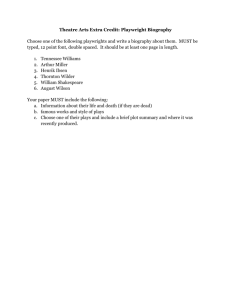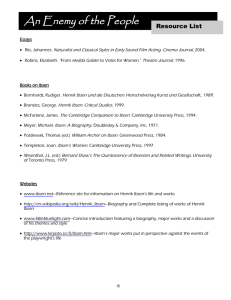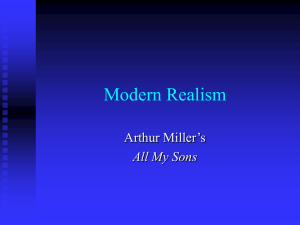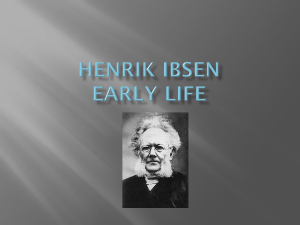Little Eyolf Study Guide
advertisement
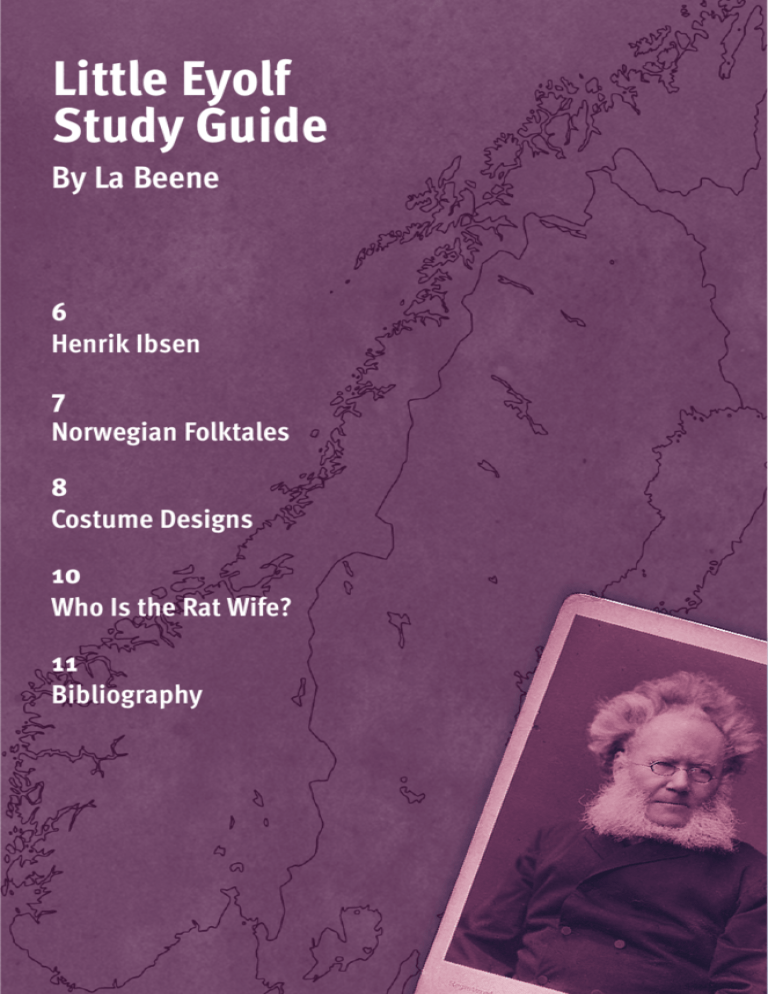
Little Eyolf Study Guide By La Beene 6 Henrik Ibsen 7 Norwegian Folktales 8 Costume Designs 10 Who Is the Rat Wife? 11 Bibliography Little Eyolf 1 Henrik Ibsen Norwegian Folktales Henrik Ibsen was born in 1828, in the town of Skien, an important shipping port in Norway. His middle-class merchant family was well connected, and Ibsen’s early years were probably very comfortable. When he was eight, his father experienced a financial loss that devastated the family, forcing them to leave their home in Skien. This experience drove their father to alcohol and their mother to church. The first publications of Norwegian Folktales were printed in the mid-19th century and reflected the wave of nationalism that permeated the country during the entire 1900s. Norway and Denmark had been united for almost 400 years before a series of Naval battles ceded Norway to Sweden. However, the Swedes seemed mainly interested in strategic shipping routes that Norway offered and the break from Denmark allowed the country to look at its Norse origins, language, and stories. Ibsen left school at age 15 to apprentice as a pharmacist, but left for Christiania (modern day Oslo) around 1846 hoping to apply to the university. This did not work out, and the young Ibsen turned to writing. His first play Cataline, a tragedy, was published in 1849 under a pseudonym, but was never performed. In 1850 he staged his first play, The Burial Mound, but it received little attention. The first collection of stories was published in 1845 by Peter Christen Asbjørnsen and Jørgen Moe who considered the folktales remnants of old Norse mythology dating back as far as the 12th century. This was a combination of the adoption of Christianity in the 10th century and relics from centuries of raiding Vikings. The authors used a simplified linguistic style in the newly formed Norwegian written language instead of focusing on the regional dialects that the original storytelling contained. A fellow artist offered Ibsen a job at Det norske Theatre in Bergen, Norway, and he spent several years there working as a writer, director, and producer. Upon his return to Christiania in 1858, he married Suzannah Thoresen who gave birth to his only (legitimate) child in 1859. In 1864 Ibsen left his family to live abroad in Italy and Germany, where he would write and work for the next 27 years. When he returned in 1891, he had gained international notoriety for his work, which includes Peer Gynt (1867), A Doll’s House (1879), Ghost (1881), An Enemy of the People (1882), The Wild Duck (1884), Hedda Gabler (1890), The Master Builder (1892), and Little Eyolf (1894). Ibsen died in his home in 1906, after several years of illness and several strokes. The day before his death, he heard his nurse remark to a visitor that he was a little better, to which he responded, “On the Contrary!” 2 Department of Theatre and Media Arts The stories were translated into English by Sir George Dasent in 1859. Popular Tales from the Norse was apparently met with approval by the original authors leading to subsequent editions including more of the folktales. University Panel Discussion on Little Eyolf Saturday, March 10, directly following the 2:00 p.m. matinee. Prof. Shirley Cox – Social Work Prof. Richard Duerden – English Prof. Nate Kramer – Scandinavian Studies Little Eyolf 3 Deanne DeWitt, costume designer Costumes Rita—Wife, Act I She wears gold, yellow, and rust colors and finer, more expensive fabrics. These represent her background as a lady of the upper class. Eyolf—Son, Act I He has a sailor suit, typical of the sort of uniforms worn by boys in the 19th century, which also shows his wish to be a soldier. 4 Department of Theatre and Media Arts Rita, Act III Her green dress is the color of the forests owned by her family. Asta—Sister, Act III She wears travelling clothes in blues and purples, chosen to represent the flowers from the Nordic countryside. Rita, Act II She has a black mourning dress, typical of clothing and customs of the Victorian Era. Little Eyolf 5 Excerpted from “Little Eyolf’s Mother—A Norwegian Medea?” By Nina Schartum Alnaes Who Is the Rat Wife? There is considerable evidence that in his later plays Ibsen continued to draw on the rich symbolism embedded in Norwegian folklore, for we find that mythological themes provide a key to the innermost meaning of several of the plays. From the age of seven Ibsen lived on the farm Venstøp in Telemark, which is the region that has best preserved the literary folk tradition in legends, ballads, and folktales. Moreover, he lived during an era when this material was still alive in the oral tradition, when books were rare. Superstition, mythical conceptions and belief in the actual existence of the figures of the folktales were deeply rooted in the population. The figure of the Rat Wife has caused considerable confusion; it has proved difficult to make her a credible character on stage. She is considered one of the unsolved riddles of Ibsen’s drama [,… but] there is evidence in literary sources that female sexuality was accorded great significance in old Norse culture [,… so] it is not surprising that mythical figures have been created to illustrate the possible consequences of repressed sexuality. Bibliography Hodne, Ornulf. The Types of Norwegian Folktale. Oslo: Universitetsforlaget: N.Y.: Columbia University Press, 1984. Meyer, Michael Leverson. Ibsen: A Biography. Garden City, N.Y.: Doubleday, 1971. Ystad, Vigdis and Hemmer. Contemporary Approaches to Ibsen. Vol. VII. Yale University Press, 1989. http://kirjasto.sci.fi/ibsen.htm http://www.theatredatabase.com/19th_century/henrik_ibsen_001.html http://www.online-literature.com/ibsen/ http://academic.brooklyn.cuny.edu/english/melani/cs6/ibsen.html Wikipedia http://www.localhistories.org/norway.html http://www.kwintessential.co.uk/resources/global-etiquette/norway-country-profile.html http://oaks.nvg.org/norwegian-folktales.html http://library.thinkquest.org/C005340/culture.php3?id=folklore/ According to popular belief, [an] unsatisfied woman […] could transform herself into an animal or an old, unmarried woman, and then perform evil deeds. When a person underwent metamorphosis and was transformed into another creature, the new manifestation was most often a werewolf. On the basis of these beliefs, it is highly feasible to interpret the Rat Wife as a werewolf, which implies that she is the embodiment of another person. And which of the characters in the play could possibly have a motive for doing what the Rat Wife does—a motive so forbidden and morbid that the idea of murder is camouflaged and disguised beyond recognition? The obvious answer is the rejected wife, Rita. Rita, who is driven by dangerous undercurrents; Rita who is tortured by the monstrous power of jealousy, and who suddenly felt the threat of the evil eye [… and is herself] translated into a physical character on stage. In [Ibsen’s] working draft the Rat Wife is called Miss Wolf. However, he probably felt that this was too obvious a clue for interpretation, so he changed her name to the Rat Wife in the final version. 6 Department of Theatre and Media Arts The Kennedy Center American College Theater Festival™ 44 sponsored in part by Stephen and Christine Schwarzman The Kennedy Center Corporate Fund U.S. Department of Education The National Committee for the Performing Arts Dr. Gerald and Paula McNichols Foundation This production is entered in the Kennedy Center American College Theater Festival (KCACTF). The aims of this national theater education program are to identify and promote quality in college-level theater production. To this end, each production entered is eligible for a response by a regional KCACTF representative, and selected students and faculty are invited to participate in KCACTF programs involving scholarships, internships, grants and awards for actors, directors, dramaturgs, playwrights, designers, stage managers, and critics at both the regional and national levels. Productions entered on the Participating level are eligible for inclusion at the KCACTF regional festival and can also be considered for invitation to the KCACTF national festival at the John F. Kennedy Center for the Performing Arts in Washington, D.C., in the spring of 2012. Last year more than 1,300 productions were entered in the KCACTF involving more than 200,000 students nationwide. By entering this production, BYU Theatre and Media Arts is sharing in the KCACTF goals to recognize, reward, and celebrate the exemplary work produced in college and university theaters across the nation. 7 Department of Theatre and Media Arts Little Eyolf 7
